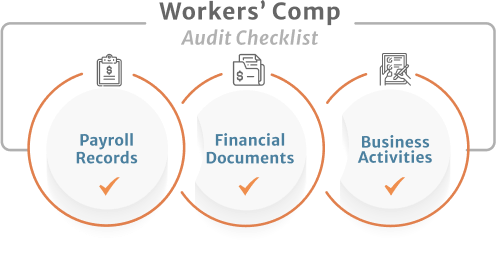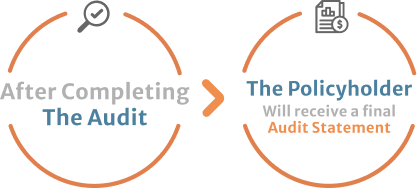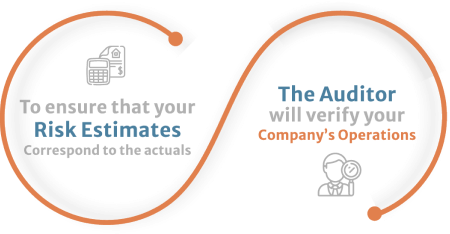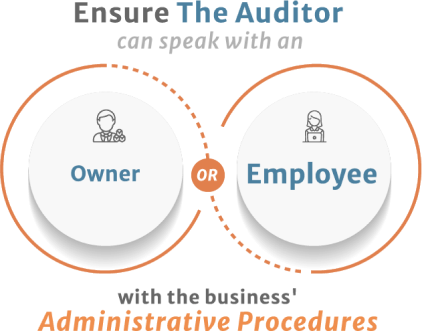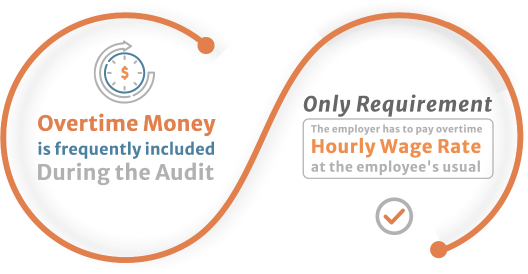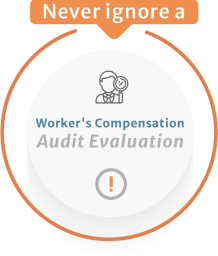Workers’ Compensation Audit Checklist
-
Payroll Records:
These include your checkbook, payroll journal, federal tax returns for the relevant period (941’s), state unemployment tax returns, or individual earnings records. All payroll records for overtime (charged at reduced rates).
-
Financial Documents:
Such as Profit and loss statements, bank statements, and tax returns confirm figures used in workers comp policy.
-
Business Activities:
A detailed description of business activities for that period.
Why Workers’ Compensation Audit?
When a worker’s compensation policy lapses, the policyholder’s financial and payroll records are subject to an audit. This procedure is carried out to assess the precision of the initial premium estimate.
After a policy’s term ends, the earned premium is recalculated based on the actual premium basis and class code exposures as opposed to the initially used estimates. Since the original quote was based on estimated payroll only, the premium charged is determined by a final audit at the end of the year to verify the payroll and subcontractor exposure.
When compared to the more traditional estimated direct bill programs, the premiums for Pay As You Go Workers’ Compensation policies can be significantly lower because they are calculated based on actual payroll and reported/paid in real-time.
A Final Audit Statement will be sent to the policyholder by the insurance company after completing the audit. Whether or not the insured owes any additional premium or whether or not there are credits to be returned or applied to the next policy will all be detailed in this statement. Payroll adjustments made by the auditor during the year-end audit are usually the root cause of these credits or debits. The auditor may also create such a group if they believe that employees were improperly categorized.
What Should I Do to Get Ready?
Although an audit is a common practice, it can be intimidating. Therefore, it is best to be well-prepared. To ensure that the auditor can complete your audit swiftly and effectively, giving them only the things they want is a good idea. Unless specifically requested, there’s no need to provide any extra information.
01. Prepare your documents beforehand.
The auditor requires your financial records for the insurance term. Depending on your provider and auditor, the particular documents and records may change.
02. Update the job descriptions you have.
Your salary and the risk your employees encounter at work are considered when calculating your workers’ compensation expenditures. To ensure that your risk estimates correspond to the actuals, the auditor will verify your company’s operations and everyone’s responsibilities.
The auditors can look at your job descriptions or request that you fill out a form outlining the duties of each employee. In either case, a solid understanding of your staff’s performance is crucial. As a good method to accomplish this, update and add more detail to your job descriptions or write new ones if you haven’t already.
03. Facilitate the auditing procedure
To speed up the process, be ready with complete and correct records. Just give the auditor what they ask for. It is more effort for you and the auditor if you provide more (or less!) information than is necessary. Ensure the auditor can speak with an owner or employee acquainted with the business’ administrative procedures.
You and the auditor will both benefit from all of this preparation.
Pro Tip
Lastly, it’s a good idea to work with the auditor on the project and review any documentation they produce. Make inquiries about anything that needs to be clarified, and avoid signing off on incomplete audit records. Always read through documents thoroughly.
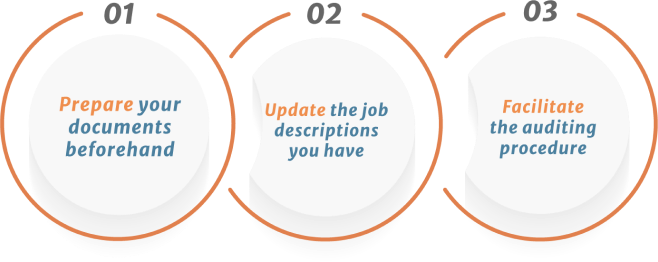
What happens when estimated payroll and audited payroll figures don’t match up?
There won’t be a cost difference if your real risk exposure or payroll matches your forecast.
Your premium for that coverage term could be lower than what you paid initially. If your real risk exposure or payroll was lower than your estimate, your insurance provider might be obligated to refund you for the difference.
If your actual risk exposure or payroll was higher than your estimate, your premium might be higher than what you initially paid, and you may be required to pay the difference to the insurance provider.
Who qualifies as an independent contractor?
An independent contractor is a person or company that offers a service for a fee. They typically work for multiple clients and set their hours and rules. If you use subcontractors, keep all agreements and invoices, especially those that detail the costs of labor and materials, separately.
Beyond that, ensure you have multiple copies of insurance and business certificates of subcontractors working for you, as you will be required to provide these certificates. If you cannot provide these, your premium will be adjusted, and you could pay more.
Pro Tip
A good advice is that you need to ensure you have multiple copies of insurance and business certificates of subcontractors working for you.
Does the payroll for workers’ compensation include overtime pay?
Because the company does not give clear records indicating which portion of wages was extra pay, overtime money is frequently included during the audit. The only requirement is that the employer pays overtime at the employee’s usual hourly wage rate. Your company must provide documentation of overtime wages split on an accurate payroll record. In some states, the sum paid to employees includes overtime compensation at a rate of two-thirds.
What if I don’t complete my workers’ comp audit?
Extreme consequences may result if you ignore a worker’s compensation audit evaluation for you and your company. You violate the terms of your contract with the insurance provider if you fail to agree to the review guidelines for workers’ compensation audit and can be slammed with a colossal non-compliance bill.
In conclusion
Most workers’ compensation auditors recognize that business does not always run as planned; thus, they are often patient and can provide extension periods. Additionally, once an audit is complete, you get up to 3-years to dispute the findings.
Have you been required to complete a Workers’ Compensation Audit?
If you have a policy with us, we can guide you through the process.


